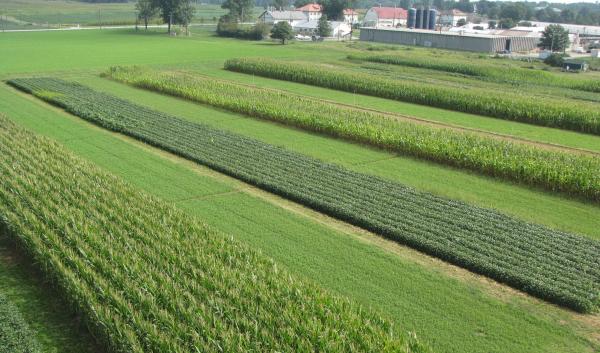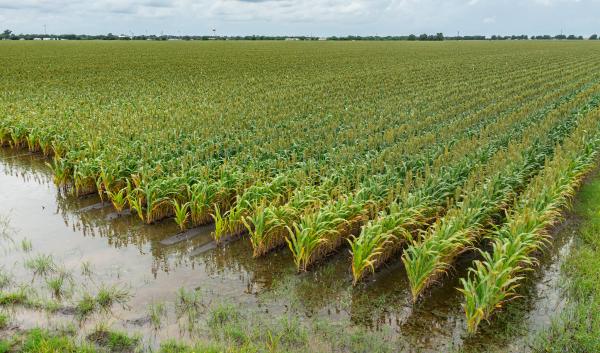Mid-Atlantic corn and soybean yields show great variability in response to precipitation during critical growth stages. Long-term agricultural research provides unique insights into the impact of climate and weather on agricultural sustainability.
The USDA-ARS Farming Systems Project (FSP) has been looking at the impact of weather on corn and soybean yields in Beltsville, Maryland, since 1996. In a recent publication1, scientists found that rainfall and heat stress during late vegetative growth and early grain filling have a large impact on yield for both conventional and organic systems. Results provide insights into possible impacts of climate change on crop yields. The FSP is a comparison of five cropping systems that mimic those used by farmers in the mid-Atlantic region. Two of the systems use conventional farming methods, including synthetic fertilizers, pesticides and genetically modified corn and soybeans. The other three use organic farming methods, which rely on legume cover crops and poultry litter for crop nutrients, and tillage and crop rotation for weed and other pest control.
Research briefThe mid-Atlantic coastal plain, where the FSP is located, has higher than average variability in corn and soybean yields compared to the most productive agricultural regions in the US. Precipitation is the primary driver of crop yield variability in this region and drought is often responsible for low yields.
At FSP, corn and soybean yields varied substantially over 18 years (Fig. 1). Furthermore, inter-annual yield variability followed similar patterns among all five systems and for both crops, and was much greater than any differences due to management. Therefore, this study focused on linking variability in precipitation and temperature with variability in yield among years. Since grain yields were not different between the two conventional systems, nor among the three organic systems, statistical analyses were conducted using mean yields for the two conventional systems compared to mean yields for the three organic systems.
Figure 1


Figure 1: Grain yield in FSP conventional and organic corn (1996-2014) and soybean (1997-2014) plots. CT and NT are the tilled and no-till conventional treatments and Org2, Org3 and Org6 are the 2-, 3-, and 6-year organic crop rotations described in Table 1.
Precipitation during crop late vegetative and reproductive stages had the largest impact on corn and soybean yields.
Precipitation during crop establishment also had an impact. When the average total combined rainfall during these two time periods was about 5 mm per week (0.2 inches), corn and soybean yields, whether conventional or organic, were only about 16 and 15 bu a-1, respectively. As this weekly precipitation increased to 30 mm (1.2 inches), conventional yields of corn increased to about 192 bu a-1 while soybean yields increased to about 60 bu a-1. Organic yields increased more slowly, peaking at an average of about 128 and 45 bu a-1 for corn and soybean, respectively. The efficiency of grain yield per unit precipitation, therefore, was greater in the conventional than the organic systems. This was partially due to weed competition in the organic systems but was also due to other unmeasured factors.
Heat stress also impacted corn yield variability.
When planting was delayed until June, heat stress did not impact corn reproductive development as severely as when corn was planted in May. This is because the critical growth period for corn planted in June occurred after the most extreme heat, most often in mid-July. But, to complicate matters, corn planted in May included both the lowest precipitation events that were associated with high heat stress, and the highest precipitation events that were associated with low heat stress. Unfortunately, this result provides little guidance to growers in selecting an optimum planting date for avoiding adverse precipitation and heat stress conditions. However, extreme weather events are predicted to increase as part of climate change. The critical importance of sufficient moisture during crop establishment and grain filling stages highlight the value of seasonal water management.




